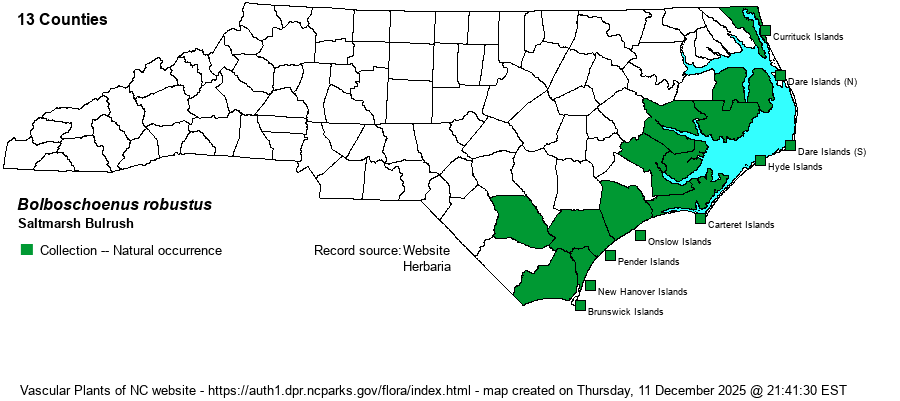| Author | (Pursh) Sojak | |
| Distribution | Restricted to tidewater counties, except for a curious record from Bladen County east of Elizabethtown. Absent from many apparently suitable marshes.
Nova Scotia to FL and TX; also in tropical America. | |
| Abundance | Uncommon to fairly common, but can be locally common. However, it is normally conspicuous where found. | |
| Habitat | Saline to brackish marshes. Occurs in the intertidal zone and upper margins of these marshes; also interdune wetlands. Sawgrass (Cladium jamaicense), Black Needlerush (Juncus roemerianus), and Common Threesquare Sedge (Schoenoplectus pungens) are often dominant in these marshes. |
| Phenology | Flowering in May-July, fruiting in June-September. | |
| Identification | In NC it is virtually unmistakable: a robust sedge of tidewater areas, up to 3 feet tall, with a compact inflorescence of elliptical brown spikelets. Note the distinct habitats; see also New England Bulrush (B. novae-angliae). | |
| Taxonomic Comments | Named as Scirpus robustus in RAB (1968). NatureServe names it as Schoenoplectus robustus.
Our species of Bolboschoenus are robust, leafy plants that inhabit tidewaters and brackish marshes. The inflorescence is composed of a few to many spikes in a compact or semi-open (B. robustus) or open (B. novae-angliae) array. Spikes are ovoid to cylindrical in shape and brown in color. The genus Bolboschoenus was formerly placed within a broad concept of Scirpus. | |
| Other Common Name(s) | Sturdy Bulrush, Saltmeadow Bulrush, and a few others | |
| State Rank | S3 [S4] | |
| Global Rank | G5 | |
| State Status | | |
| US Status | | |
| USACE-agcp | | |
| USACE-emp | | |

